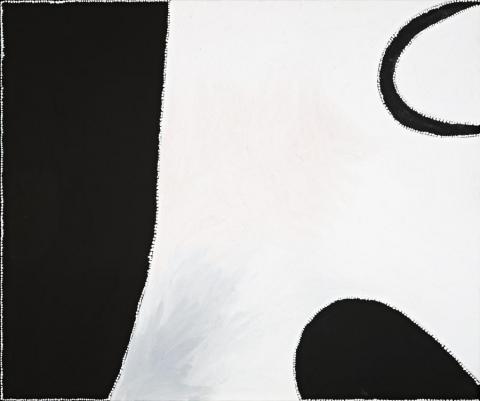MERRMERRJI - QUEENSLAND CREEK, 2004
PADDY NYUNKUNY BEDFORD
natural earth pigments with synthetic binder on linen
150.5 x 180.0 cm
inscribed verso: title and Jirrawun Aboriginal Arts cat. PB 6 2004.174
Jirrawun Aboriginal Arts Corporation, Kununurra, acquired 2004
The K.D.H. Ainsworth Collection, Queensland
Paddy Bedford, Museum of Contemporary Art, Sydney, 6 December 2006 - 15 April 2007; Art Gallery of Western Australia, Perth, 12 May - 22 July 2007; Bendigo Art Gallery, Victoria, 11 August - 16 September 2007, University of Queensland Art Museum, Brisbane, 16 November 2007 - 2 March 2008
Storer, R., Paddy Bedford, Museum of Contemporary Art, Sydney, 2006, p. 154 (illus.)
The magic of Paddy's paintings is that their narratives extend beyond the literal, beyond the single allegory. Yes, there is always a story, but importantly there is also a non-verbal story that is more like music and poetry.'1
A glimpse into another majestic landscape from Paddy Bedford's home country, Merrmerrji depicts an area in the north-east of Bedford Downs which runs alongside the Wilson River, and is memorable for the many creeks and waterholes that populate the region. Drawing from the stylistic traditions of many East Kimberley artists before him, Bedford continues an aesthetic of rendering sparse expanses of land, divided by uninterrupted lines and bold contours.
There is a compelling power to the play between positive and negative spaces in Bedford's landscapes, one that does not rely on the repetition of shapes or formula to engage the eye. Here, the contrast of black and white planes combined with the vertical rotation of the horizon line creates an abstract but somehow rhythmic experience of the artist's country.
In the right-hand corners of our painting we encounter the bulging contours of two waterholes. Unlike much Central and Western Desert painting, Bedford's shapes are not repeated in rows or in a methodical design. Instead these forms are unique and asymmetrical. They create a dynamic compositional juxtaposition to the continuous horizon line. It is worth noting too, that the waterholes are not centred. They emerge from the very edges of the composition and remind us that this landscape extends outside the limits of the canvas - it stretches boundlessly beyond what the eye can see.
Paddy Bedford is one of Australia's most esteemed artists. Born at Bedford Downs in the East Kimberley region of Western Australia, he began painting in 1998 while in his mid-seventies. Since he first picked up a paintbrush, he has become an artistic innovator, leader, and legend. Bedford was heavily influenced by his contemporaries - including Rover Thomas, Paddy Jaminji and Freddie Timms - but it was only after the deaths of these artistic pioneers that Bedford first began to paint, as if picking up where they had left off, carrying his history and his traditions forward into a new era.
1. Oliver, T., 'Preface', in Storer, R., Paddy Bedford, Museum of Contemporay Art, Sydney, 2006, p. 9
LEAH CROSSMAN
